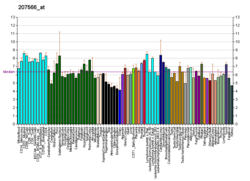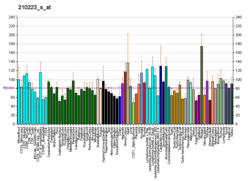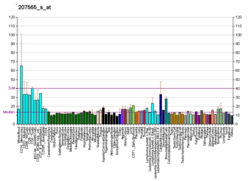Major histocompatibility complex, class I-related
Major histocompatibility complex class I-related gene protein is a protein that in humans is encoded by the MR1 gene.[5][6][7] The MR1 protein is able to bind to molecules derived from bacterial riboflavin biosynthesis, and then present it to mucosal associated invariant T cells for activation.[8][9]
References
- 1 2 3 GRCh38: Ensembl release 89: ENSG00000153029 - Ensembl, May 2017
- 1 2 3 GRCm38: Ensembl release 89: ENSMUSG00000026471 - Ensembl, May 2017
- ↑ "Human PubMed Reference:".
- ↑ "Mouse PubMed Reference:".
- ↑ Hashimoto K, Hirai M, Kurosawa Y (Aug 1995). "A gene outside the human MHC related to classical HLA class I genes". Science. 269 (5224): 693–5. doi:10.1126/science.7624800. PMID 7624800.
- ↑ Yamaguchi H, Kurosawa Y, Hashimoto K (Nov 1998). "Expanded genomic organization of conserved mammalian MHC class I-related genes, human MR1 and its murine ortholog". Biochem Biophys Res Commun. 250 (3): 558–64. doi:10.1006/bbrc.1998.9353. PMID 9784382.
- ↑ "Entrez Gene: MR1 major histocompatibility complex, class I-related".
- ↑ Corbett, Alexandra J.; Eckle, Sidonia B. G.; Birkinshaw, Richard W.; Liu, Ligong; Patel, Onisha; Mahony, Jennifer; Chen, Zhenjun; Reantragoon, Rangsima; Meehan, Bronwyn. "T-cell activation by transitory neo-antigens derived from distinct microbial pathways". Nature. 509 (7500): 361–365. doi:10.1038/nature13160.
- ↑ Kjer-Nielsen, Lars; Patel, Onisha; Corbett, Alexandra J.; Nours, Jérôme Le; Meehan, Bronwyn; Liu, Ligong; Bhati, Mugdha; Chen, Zhenjun; Kostenko, Lyudmila. "MR1 presents microbial vitamin B metabolites to MAIT cells". Nature. doi:10.1038/nature11605.
Further reading
- Maruyama K, Sugano S (1994). "Oligo-capping: a simple method to replace the cap structure of eukaryotic mRNAs with oligoribonucleotides". Gene. 138 (1–2): 171–4. doi:10.1016/0378-1119(94)90802-8. PMID 8125298.
- Yamaguchi H, Hirai M, Kurosawa Y, Hashimoto K (1997). "A highly conserved major histocompatibility complex class I-related gene in mammals". Biochem. Biophys. Res. Commun. 238 (3): 697–702. doi:10.1006/bbrc.1997.7379. PMID 9325151.
- Suzuki Y, Yoshitomo-Nakagawa K, Maruyama K, et al. (1997). "Construction and characterization of a full length-enriched and a 5'-end-enriched cDNA library". Gene. 200 (1–2): 149–56. doi:10.1016/S0378-1119(97)00411-3. PMID 9373149.
- Riegert P, Wanner V, Bahram S (1998). "Genomics, isoforms, expression, and phylogeny of the MHC class I-related MR1 gene". J. Immunol. 161 (8): 4066–77. PMID 9780177.
- Parra-Cuadrado JF, Navarro P, Mirones I, et al. (2001). "A study on the polymorphism of human MHC class I-related MR1 gene and identification of an MR1-like pseudogene". Tissue Antigens. 56 (2): 170–2. doi:10.1034/j.1399-0039.2000.560211.x. PMID 11019920.
- Strausberg RL, Feingold EA, Grouse LH, et al. (2003). "Generation and initial analysis of more than 15,000 full-length human and mouse cDNA sequences". Proc. Natl. Acad. Sci. U.S.A. 99 (26): 16899–903. doi:10.1073/pnas.242603899. PMC 139241. PMID 12477932.
- Miley MJ, Truscott SM, Yu YY, et al. (2003). "Biochemical features of the MHC-related protein 1 consistent with an immunological function". J. Immunol. 170 (12): 6090–8. doi:10.4049/jimmunol.170.12.6090. PMID 12794138.
- Hempelmann A, Kumar S, Muralitharan S, Sander T (2007). "Myofibrillogenesis regulator 1 gene (MR-1) mutation in an Omani family with paroxysmal nonkinesigenic dyskinesia". Neurosci. Lett. 402 (1–2): 118–20. doi:10.1016/j.neulet.2006.03.048. PMID 16632198.
This article is issued from
Wikipedia.
The text is licensed under Creative Commons - Attribution - Sharealike.
Additional terms may apply for the media files.






